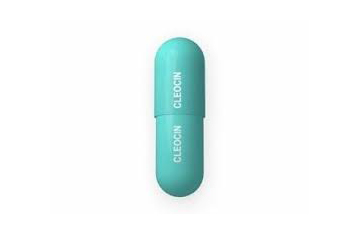
- Names: Generic Cleocin (Clindamycin)
- Dosage: 150mg | 300mg
- Price: $1.10 per pill
Generic Cleocin (Clindamycin) is an antibiotic used for treating serious bacterial infections. is in a class of medications called lincomycin antibiotics.
Visit Online PharmacyWhere to buy Cleocin over the counter?
You can hardly find this antibiotic sold over the couter in your city pharmacy. However, some online pharmacies offer to buy antibiotics without a prescription. Our pharmacy is an example of such a company. Whne ordering dugs online, there is no need to waste time on a long and often unsuccessful search for the necessary antibiotics in your city. We provide the widest range of antibiotics at competitive prices. You can find and order any anti-bacterial product with home delivery. We offer only high-quality and certified products.

You only need to choose the necessary product, add it to the shopping cart, fill out a short order form, and proceed to checkout. The whole process won’t take much time.
How much does Cleocin cost?
Your local pharmacies sell expensive branded antibiotics, and not evey patient can afford them. To save money, you can order medicine via the Internet, use promotions, and discounts. Due to the fact that medicines are sold on the web, an online pharmacy reduces staff costs and rental of premises, and this has a positive effect on the cost of drugs. If you want to get cheaper antibiotics, place an order through our website. Moreover, our online pharmacy specializes on generics which also means you can save a significant amount. For example, here you can buy Generic Cleocin for only $ 1.36 per pill. This is the lowest possible price for this drug.
What Cleocin used to treat?
The drug is used to treat severe infectious and inflammatory diseases caused by microorganisms sensitive to clindamycin:
- infections of the upper respiratory tract and ENT organs, including: chronic sinusitis caused by anaerobic bacteria; otitis media (subject to the simultaneous use of antibacterial drugs active against aerobic gram-negative microorganisms), recurrent pharyngotonsillitis;
- scarlet fever;
- lower respiratory tract infections, including: bronchitis, pneumonia, empyema, and lung abscess;
- infections of the skin and soft tissues, including: acne, furunculosis, cellulitis (phlegmon), impetigo, abscesses, infected wounds, erysipelas;
- infectious diseases of bones and joints, including: osteomyelitis and septic arthritis;
- inflammatory gynecological diseases of the pelvic organs (endometritis, salpingitis, abscesses of the fallopian tubes and ovaries) and pelvic peritonitis (with the simultaneous use of antibacterial drugs active against aerobic gram-negative microorganisms);
- intra-abdominal infections, including peritonitis and abscesses of the abdominal cavity (subject to the simultaneous use of antibacterial drugs active against aerobic gram-negative microorganisms);
- septicemia and bacterial endocarditis;
- infections of the oral cavity, including: periodontal abscess and periodontitis;
- toxoplasmosis encephalitis in patients with AIDS (in combination with pyrimethamine) with intolerance to standard therapy;
- pneumonia caused by Pneumocystis jiroveci (formerly Pneumocystis carinii) in patients with AIDS (in combination with primaquine) with intolerance or resistance to standard therapy;
- malaria caused by Plasmodium falciparum, including multidrug resistance (in combination with quinine).
Sensitivity to in vitro antibiotics varies depending on the geographical region and over time, therefore, when choosing antibiotic therapy, local information on resistance should be taken into account.
How does it work?
Clindamycin is a semi-synthetic antibiotic-linkosamide formed from lincomycin when the 7- (R) -hydroxyl group is replaced by 7- (S) -chlor, active against aerobic gram-positive microorganisms and a wide range of anaerobic bacteria. Most gram-negative aerobic bacteria, including Enterobacteriaceae, are resistant to clindamycin.
Clindamycin binds to the 50S subunit of the ribosome and inhibits protein synthesis in bacterial cells, disrupting the process of extension of the protein chain. The substance is able to inhibit the binding process of aminoacyl t-RNA and the translocation reaction that occurs after the attachment of an amino acid molecule to the ribosome.
Depending on the sensitivity of the microorganism and the concentration of the drug, clindamycin can act bacteriostatically (mainly) or bactericidal (in high concentrations).
What type of bacteria does clindamycin treat?
The antibiotic is active against aerobic and anaerobic streptococci (with the exception of enterococci), most staphylococci (with the exception of methicillin-resistant strains), bacteroides (with the exception of Bacteroides melaninogenicus), spindle-shaped bacteria, Actinomyces israelii, Clostridiumperfringens and C. tetani. It is mainly used against the above anaerobes. The drug is ineffective against gram-negative organisms and many types of clostridia.
How long does Cleocin take to work?
Once you start taking the antibiotic, you’ll likely feel better after a day or two. If your symptoms persist and does not get better at all or you start feeling worse after taking this drug for a few days, contact your local healthcare provider.
How to take this medicine?
The recommended dose and therapy duration is determined by a doctor who will take into account the age, diagnosis and course of the patient’s disease. The tablets are taken before meals or after meals, depending on the symptoms of the existing pathology.
Do not lie down for at least 10 minutes after taking this drug.
It becomes clear whether the drug is effective treatment or not within the first 48-72 hours – you should notice a general improvement in your condition, your temperature should lower and the and laboratory parameters should improve. If you do not feel better or you feel worse, then you need to replace the treatment with another antibiotic (doctor’s advice is required). If you do feel better, you should NOT stop taking the tablets. This may cause bacterial resistance.
Never increase the dose of clindamycin on your own, this can provoke side effects.
Do not miss the hours of taking the tablets (usually every 8-12-24 hours, respectively 3-2-1 times a day) and if you missed it, do not take a double dose immediately.
If you are taking any drugs because of chronic diseases, tell your doctor about this to exclude the negative interaction of the drugs.
The dose calculation for the child is selected by weight and depends on the infection.
If you have ever experienced an allergic reaction to antibiotics, be sure to tell your doctor about this, some groups have cross-allergic reactions.
Which dosage is right for me?
The available dosage options are Cleocin 300 mg and 150 mg. The drug can be used by adults and teenagers over 15 years of age. Only a doctor can choose the best dose of the antibiotic for your health condition.
- For diseases of moderate severity: 150 mg 4 times / day (every 6 hours);
- For severe infections: a single dose may be increased to 300-450 mg.
Who should not take this medicine?
Contraindications for this antibiotic include:
- hypersensitivity;
- myasthenia gravis;
- bronchial asthma;
- ulcerative colitis (history);
- diarrhea;
- pregnancy;
- breatfeeding;
- rare hereditary diseases, such as galactose intolerance, lactase deficiency or glucose-galactose malabsorption.
What are the side effects of Cleocin?
- Infectious and parasitic diseases: pseudomembranous colitis, vaginal infections;
- Blood and lymphatic system disorders: eosinophilia, agranulocytosis, neutropenia, leukopenia, thrombocytopenia;
- Immune system disorders: anaphylactic shock, anaphylactoid reactions, anaphylactic reaction, hypersensitivity;
- Nervous system violations: a perversion of taste;
- Heart disturbances: respiratory arrest and cardiac activity;
- Vascular disorders: thrombophlebitis, low blood pressure;
- Gastrointestinal tract disorders: abdominal pain, diarrhea, nausea, vomiting, pricks, esophageal ulcer, esophagitis;
- Liver and biliary tract violations: impaired liver function, jaundice;
- Skin and subcutaneous tissues disorders: maculopapular rash, urticaria, erythema multiforme, skin itching, toxic epidermal necrolysis, Stevens-Johnson syndrome, drug rash with eosinophilia and systemic symptoms (DRESS-syndrome), exfoliative and vesiculo-bullous dermatitis, generalized measles-like rash of mild to moderate severity, acute generalized exanthesis.
Overdose
An overdose of clindamycin does not case any specific symptoms (its toxicity is not associated with an increase in dose).
Treatment is symptomatic and supportive. Clindamycin is not excreted by hemodialysis and peritoneal dialysis.
Pregnancy and breastfeeding
In animal studies, when clindamycin was administered subcutaneously or orally, effects on fertility, as well as any negative effects on the fetus, were not detected, except in cases of taking the drug in toxic doses.
Clindamycin crosses the placenta. After the introduction of several doses of the drug, the concentration in the amniotic fluid was about 30% of the concentration in the mother’s blood. In clinical trials with systemic administration of the drug to women during the II and III trimester of pregnancy, there was no increase in the frequency of congenital malformations of the fetus. Studies of the use of the drug in the first trimester of pregnancy have not been conducted.
The drug should not be used in the first trimester of pregnancy. In the second and third trimesters of pregnancy, it is used only when the intended benefit to the mother outweighs the potential risk to the fetus.
Benzyl alcohol can cross the placenta.
Clindamycin is found in breast milk at a concentration of 0.7-3.8 μg / ml.
If it is necessary to use the drug during lactation, breastfeeding must be stopped.
Drugs that may interact with Cleocin
Do not combine this antibiotic with any of the following drugs:
- erythromycin;
- chloramphenicol;
- other neuromuscular blockers or muscle relaxants of peripheral action, such as vecuronium bromide, rocuronium bromide, gentamicin, rapacuronium
- bromide (with magnesium) or pancuronium bromide;
- with vitamin K antagonists (e.g. warfarin, acenocoumarol and fluindione);
- ampicillin;
- phenytoin;
- barbiturates;
- aminophylline;
- calcium gluconate;
- magnesium sulfate;
- ceftriaxone;
- ciprofloxacin.
Should I avoid certain foods while taking this antibiotic?
You should not combine the drug with with dairy products. They contain calcium, which binds a significant part of the drug, as a result of which it passes through the digestive tract without being absorbed. You will receive at best twenty percent of the desired dose.
Carbonated drinks are also in constant conflict with antibiotics. Soda contains a lot of calcium and also iron. And if you take an antibiotic with soda, the drug will not be absorbed.
Do not combine the medicine with acidic fruits, juices and any dishes containing vinegar.
Can I drink alcohol when taking Cleocin?
No, you should not drink alcohol when using Cleocin. Alcohol enhances the side effects of antibiotics: drowsiness, dizziness, mild nausea, indigestion, severe headache, stomach cramps and vomiting, excessive sweating, cardiopalmus, a sharp increase in blood pressure, liver damage.
Keep in mind that the body is also weakened by the infection at this time, and drinking alcohol (even at small doses) can slow recovery. You can start drinking alcohol only 3 days after cessation of therapy.
Warnings and precautions
Take this medicine with caution if you have gastrointestinal diseases (history), especially colitis, myasthenia gravis, severe hepatic and / or renal failure, bronchial asthma.
If hypersensitivity reactions occur, treatment with clindamycin should be discontinued.
Antibacterial drugs suppress the normal intestinal flora, which can contribute to increased reproduction of clostridia. There have been reported cases of pseudomembranous colitis of varying severity.
It has been proven that toxins produced by Clostridium difficile are the main cause of colitis associated with antibiotic therapy. Diarrhea, colitis, symptoms of pseudomembranous colitis can appear both with the use of clindamycin, and 2-3 weeks after cessation of therapy.
Pseudomembranous colitis is manifested by diarrhea, leukocytosis, fever, abdominal pain (sometimes accompanied by excretion of fecal blood and mucus). Therefore, in cause you have diarrhea after taking antibacterial drugs, the possibility of this diagnosis should be considered.
In patients over 60 years of age, antibiotic-associated colitis and diarrhea (caused by Clostridium difficile) are more common and may be more severe.
If superinfection develops, appropriate measures should be taken depending on the clinical situation.
During treatment, caution should be exercised during work of drivers of vehicles and people whose profession is associated with an increased concentration of attention (the drug can cause dizziness).
Cleocin reviews
Most patient reviews available on the net are positive.
One female patient says that this is inexpensive and fast-working antibiotic. But, unfortunately, it caused an adverse reaction – a mild indigestion. She adds it was a mere trifle.
Another female patient used Cleocin to restore her regular menstrual cycle. Such a problem arose due to a violation in the bacterial microflora. The woman completed a course of the drug prescribed by her gynecologist and it helped. She had no adverse reactions and was satisifed with the drug.
One more female patient used this drug a couple of times for her vaginosis. She was satisfied with the result. And her doctor also prescribed this antibiotic for the treatment of acne.
Finally, one male patient bought this medicine over the counter to treat pneumonia. He says the drug works quickly and causes no adverse reactions. But he also reminds that everything is very individual and the treatment should be prescribed by a doctor.
Watch a video with more information about clindamycin (Cleocin): side effects, benefits, uses, warnings, precautions, administration, mechanism of action, and answers to questions like: “what is clindamycin?”
